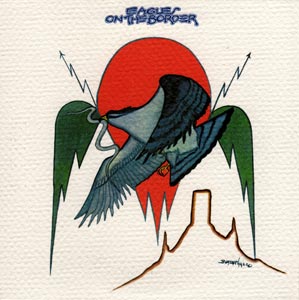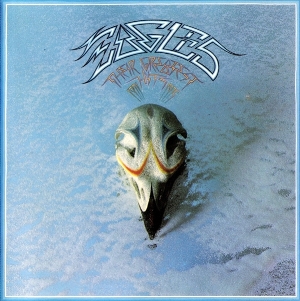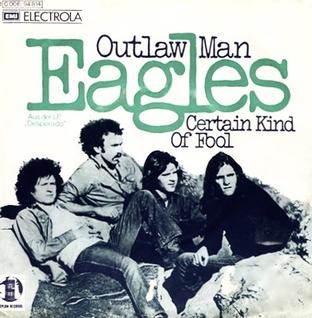
The Eagles are an American rock band formed in Los Angeles in 1971. With five number-one singles and six number-one albums, six Grammy Awards and five American Music Awards, the Eagles were one of the most successful musical acts of the 1970s in North America and are one of the world's best-selling bands, having sold more than 200 million records worldwide, including 100 million sold in the US alone. They were inducted into the Rock and Roll Hall of Fame in 1998 and were ranked number 75 on Rolling Stone's 2004 list of the "100 Greatest Artists of All Time". Founding members Glenn Frey, Don Henley, Bernie Leadon, and Randy Meisner were recruited by Linda Ronstadt as band members, some touring with her, and all playing on her third solo album, before venturing out on their own on David Geffen's new Asylum Records label.

Donald Hugh Henley is an American musician, and a founding member of the rock band Eagles, for whom he is the drummer and one of the lead vocalists, as well as the sole continuous member of the band. Henley sang the lead vocals on Eagles hits such as "Witchy Woman", "Desperado", "Best of My Love", "One of These Nights", "Hotel California", "Life in the Fast Lane", "Victim of Love", "The Last Resort", "The Long Run", and "Get Over It".

Glenn Lewis Frey was an American musician. He was a founding member of the rock band the Eagles. Frey was the co-lead singer and frontman for the Eagles, roles he came to share with fellow member Don Henley, with whom he wrote most of the Eagles' material. Frey played guitar and keyboards as well as singing lead vocals on songs such as "Take It Easy", "Peaceful Easy Feeling", "Tequila Sunrise", "Already Gone", "James Dean", "Lyin' Eyes", "New Kid in Town", and "Heartache Tonight".

Desperado is the second studio album by the American band the Eagles. It was released on April 17, 1973, by Asylum Records. The album was produced by Glyn Johns and was recorded at Island Studios in London, England. The songs on Desperado are based on the themes of the Old West. The band members are featured on the album's cover dressed like an outlaw gang; Desperado remains the only Eagles album where the band members appear on the front cover.

Eagles is the debut studio album by American rock band the Eagles. The album was recorded at London's Olympic Studios with producer Glyn Johns and released on June 1, 1972. It was an immediate success for the then-new band, reaching No. 22 on the Billboard 200 and achieving a platinum certification from the Recording Industry Association of America (RIAA). Three singles were released from the album, each reaching the Top 40 of the Billboard Hot 100: "Take It Easy", "Witchy Woman", and "Peaceful Easy Feeling". The band, starting with this album, played a major role in popularizing the country rock sound.

On the Border is the third studio album by American rock band the Eagles, released on March 22, 1974. Apart from two songs produced by Glyn Johns, it was produced by Bill Szymczyk because the group wanted a more rock‑oriented sound instead of the country-rock feel of the first two albums. It is the first Eagles album to feature guitarist Don Felder. On the Border reached number 17 on the Billboard album chart and has sold two million copies.

Their Greatest Hits (1971–1975) is the first compilation album by the American rock band the Eagles, released by Asylum Records on February 17, 1976. It contains a selection of songs from the band's first four albums, which were released from 1972 to 1975. On the U.S. Billboard 200 chart, the album reached number one, where it stayed for five weeks.

Donald William Felder is an American musician who was the lead guitarist of the rock band Eagles from 1974 until his termination from the band in 2001. He was inducted into the Rock and Roll Hall of Fame in 1998 with the Eagles. Felder was inducted into the Musicians Hall of Fame and Museum in 2016.

Randall Herman Meisner was an American musician, singer, songwriter, and founding member of the Eagles. Throughout his professional musical career, Meisner's main role was that of bassist and backing high-harmony vocalist as a group member and session musician. He co-wrote and provided lead vocals on the Eagles hit song "Take It to the Limit".
"Desperado" is a soft rock ballad by the American rock band the Eagles. The track was written by Glenn Frey and Don Henley, and appeared on the 1973 album Desperado as well as numerous compilation albums. Although it was never released as a single, it became one of Eagles' best-known songs. It ranked No. 494 on Rolling Stone's 2004 list of "The 500 Greatest Songs of All Time".

"Best of My Love" is a song written by Don Henley, Glenn Frey, and J. D. Souther. It was originally recorded by the Eagles, and included on their 1974 album On the Border. The song was released as the third single from the album, and it became the band's first Billboard Hot 100 number 1 single in March 1975. The song also topped the easy listening chart for one week a month earlier. Billboard ranked it as the number 12 song for 1975.

"One of These Nights" is a song written by Don Henley and Glenn Frey and recorded by the American rock band Eagles. The title track from their 1975 One of These Nights album, the song became their second single to top the Billboard Hot 100 chart after "Best of My Love" and also helped propel the album to number one. The single version was shortened from the album version of the song, removing most of the song's intro and most of its fade-out, as well. Henley is lead vocalist on the verses, while Randy Meisner sings high harmony on the refrain. The song features a guitar solo by Don Felder that is "composed of blues-based licks and sustained string bends using an unusually meaty distortion tone."

"Take It Easy" is the debut single by the American rock band Eagles, written by Jackson Browne and Eagles band member Glenn Frey, who also provides lead vocals. It was released on May 1, 1972, and peaked at No. 12 on the Billboard Hot 100 chart on July 22, 1972. It was also the opening track of the band's eponymous debut album and has become one of their signature songs, included on all of their live and compilation albums. It is listed as one of The Rock and Roll Hall of Fame's 500 Songs that Shaped Rock and Roll.

"Lyin' Eyes" is a song written by Don Henley and Glenn Frey and recorded in 1975 by the American rock band Eagles, with Frey singing lead vocals. It was the second single from their album One of These Nights, reaching No. 2 on the Billboard Hot 100 chart and No. 8 on the Billboard Country chart. It remained their only top 40 country hit until "How Long" in 2007–2008.

"James Dean" is a song written by Don Henley, Glenn Frey, Jackson Browne, and J. D. Souther, and recorded by the American rock band Eagles for their 1974 album On the Border. It was the second single released from this album, reaching number 77 on the U.S. pop singles chart.

"Take It to the Limit" is a song by the Eagles from their fourth album One of These Nights from which it was issued as the third single on November 15, 1975. It reached No. 4 on the U.S. Billboard Hot 100 and was also the Eagles' greatest success to that point in the UK, going to No. 12 on the charts. Billboard ranked it as the No. 25 song for 1976.

"Outlaw Man" is a song written by David Blue and recorded by the American rock band Eagles. The song was chosen by the Eagles for their second album Desperado as the song fits the theme of a Western outlaw gang of the album. It is the second single released from Desperado after "Tequila Sunrise", and the eighth track on the album.

"Tequila Sunrise" is a song from 1973, written by Don Henley and Glenn Frey, and recorded by the Eagles. It was the first single from the band's second album, Desperado. It peaked at number 64 on the Billboard Hot 100.

"Witchy Woman" is a song written by Don Henley and Bernie Leadon, and recorded by the American rock band Eagles. Released as the second single from the band's debut album Eagles, it reached No. 9 on the Billboard pop singles chart.

Live from the Forum MMXVIII is the third live album and a concert film from the Eagles. It records the concerts at the Forum in Inglewood, California that took place over three nights in September 2018. It is the first release to feature new band members Deacon Frey and Vince Gill alongside Don Henley, Joe Walsh and Timothy B. Schmit. Deacon, son of the late former band member Glenn Frey, and Gill joined the band following the death of the elder Frey in 2016. It was released on October 16, 2020, in a variety of formats, including CD, DVD and Blu-ray.



















